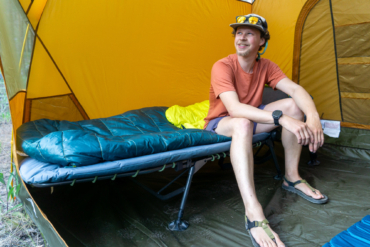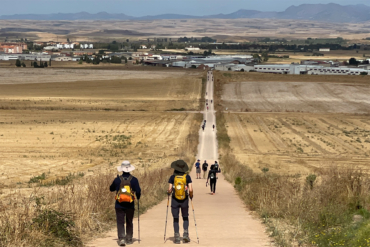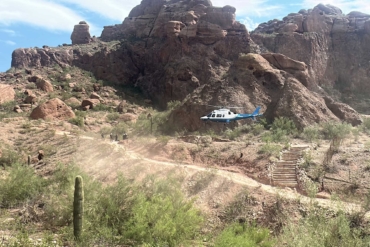By taking the time to learn how to employ a variety of safety strategies around our ursine friends, you can safely enjoy a bear encounter. Promise.
In my 6 years of hiking, backpacking, hunting, and fishing, I’ve experienced countless interactions with bears. And the great majority of the time, I’ve enjoyed those encounters while remaining safe and physically intact. However, I was reminded of the power bears hold in our collective imagination on a recent llama-packing trip into Yellowstone National Park.
Over the course of 4 days, we had close personal encounters with black bears on the trail, a 4 a.m. bear scare in camp (everything was fine), and constant vigilance to remind each other that we were in grizzly country and we’d better take the right measures to avoid encounters. Well, we did take those measures.
And, although I wouldn’t have minded seeing one of these powerful silver-tipped creatures from a safe distance, we luckily avoided the famed Grizz entirely.
Because We All Love Good Bear Data
When I first started going into the woods here in Montana, bears were constantly on my mind. And I was scared. Bears are mostly unknown to us suburbanites and city folk. And I live, work, and play in areas in which I share space with both grizzlies and black bears.
Really, there’s no small wonder why I felt fear about this. The media greatly sensationalizes bear attacks. But we forget that people interact with these furry creatures all the time with no harm done. Yellowstone reports that one out of every 2.7 million visitors is attacked by a bear, with thousands of visitors privy to encounters, both near and far, in any given year.
It is worth pointing out that the great majority of Yellowstone visitors don’t even leave the pavement. The odds change dramatically if you decide to take a jaunt in the backcountry, with one bear attack per 232,616 travel days.
Of course, bears exist outside of Yellowstone, but it’s a hell of an experiment in nearly constant encounters with people and both grizzlies and black bears. And the numbers … ahem … bear out on the side of humans staying physically intact. And, if you follow the general wildlife-human encounters in Yellowstone, you’ll know the animals are generally much more tolerant of human idiocy than we ever give them credit for.
How to Stay Safe in Bear Country

The Yellowstone Pledge effort combats that idiocy while giving a nice, solid starting point for a behavioral code you can apply beyond the park. And the following rules from the pledge apply directly to wildlife.
- Give wildlife room, use a zoom. The safest way to view wildlife is through a telephoto lens, a spotting scope, or a pair of binoculars. Park animals are wild and dangerous. Bison, bears, and elk have injured and killed people. Do not approach, encircle, follow, or feed any animal. Stay 100 yards (91 m) from bears and wolves. Stay 25 yards (23 m) from all other animals.
- Be bear aware. Carry bear spray and know how to use it. Be alert, make noise, hike in groups, and stay on trails. If you encounter a bear, never run.
The first rule is easy to follow if you’re in the general vicinity of the road or in a public place. But things get a bit more tenuous in the backcountry; I keep my bear spray within quick reach at all times. And in areas where visibility is low — say, a thick grove of quaking aspen or willows by a river — I make noise to let animals know I am indeed not one of them.
I also suggest committing the differences between black bears and grizzlies to memory. If a black bear does approach, you’ll want to be aggressive and fight back. With grizz, your best bet is to be as nonthreatening as possible, avoid eye contact, and play dead in a physical interaction. Knowing the difference can save your life.
Lastly, GearJunkie has a full tutorial on best practices for bear spray. I suggest a detailed reading as well as asking your nearest park ranger or public lands employee how to deploy it.
And That Whole ‘Enjoy’ Part Comes Next
While hiking from one backcountry campsite to another, I turned a corner, and there stood a small adult black bear, about 15 feet away. Calmy, I said, “Hey, bear,” and slowly talked to her as she checked me out and then walked into the brush. The whole encounter lasted less than 10 seconds, and it was a perfect example of how these things typically go: very suddenly, very calmly, and over as soon as it started.
And although I was highly present in that moment, there was no sense of fear. I was prepared, I was calm, and I was simply a moving part in the ecosystem. I didn’t stop to take a picture. and I made haste out of her area.
Once I got to a safe distant vantage point, I finally stopped to see if I could see her moving in the woods. This moment, in many ways, made my trip. To have a brief, safe encounter with a bear makes me grateful for the ability to coexist with these creatures, and it provides a deep and immediate connection to the unknowable nature of what is wild.
And I learned all these behaviors through the wide variety of educational sources I’ve pored over and committed to memory. This gives me a solid and firm belief that, heck, if I can enjoy a bear encounter, anyone can.
Final Thoughts on Bear Safety

There isn’t as much to be afraid of as my cityfied brain formerly indicated. At least that’s what both the data and my anecdotal experience tells me.
But, in practice, it’s taken a few hundred miles, a diligent acquaintance with bear spray, and some really cool but benign encounters to make my fear feel less ominous. My personal arkoudaphobia (fear of bears) has transitioned into a feeling of being present, being respectful, and knowing my options for personal safety.
And my wish is for anyone going into the woods to experience that same shift of personal power from fear to courage when it comes to these incredible animals. Be prepared, carry bear spray, and stay present. Beary good things await you.








